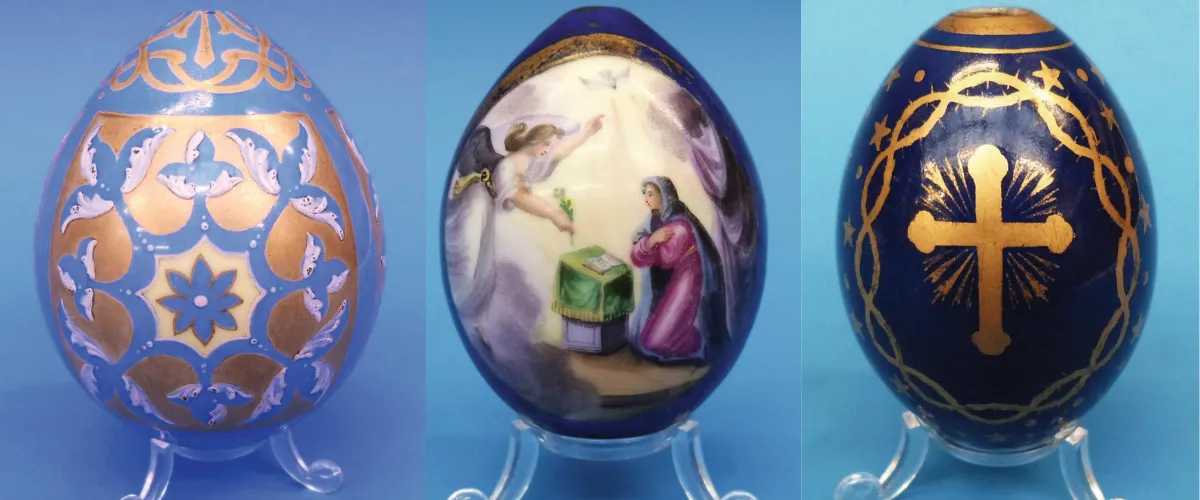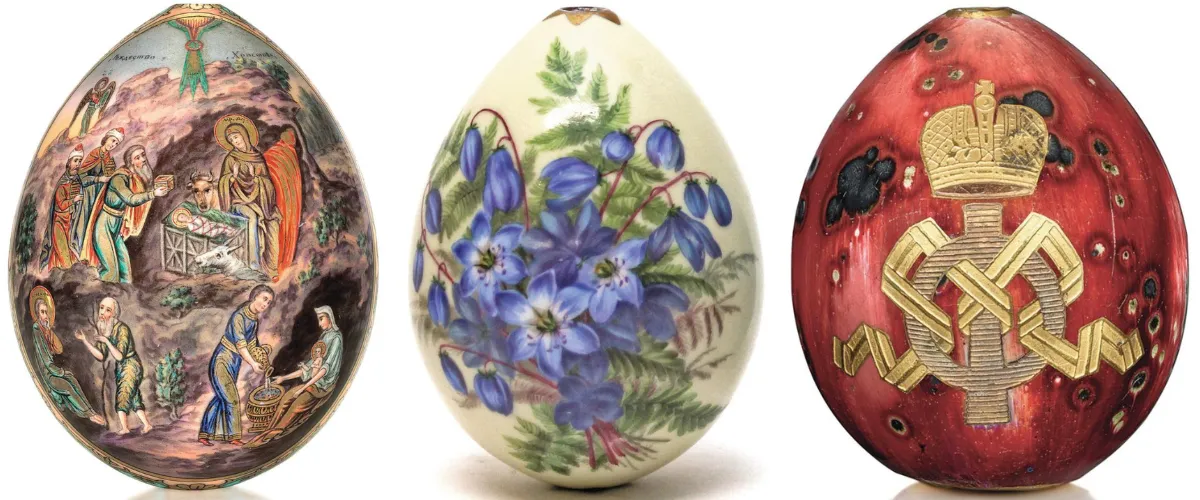Russian Easter eggs are a unique phenomenon in the world of porcelain. At first solely a privilege of Russian emperors and empresses, they were exchanged between those close to the Imperial family.
The tradition began with eggs made of wood, glass and hardstone until the first porcelain eggs were made in the late 1740s. This was a few years after the Imperial Porcelain Factory was founded in 1744 by the order of Empress Elizabeth I, a great supporter of the arts. In the 19th century the production of small porcelain eggs became more common as the practice of giving them as Easter gifts spread to the masses.
Today, these eggs are rare mementoes of Imperial Russia, highly prized by international collectors of Russian art. When I was growing up in Ukraine, Easter was very special. We used to paint eggs and give them to friends and family on Easter day. Porcelain eggs are a reminder of that ancient tradition that still exists.
What is the Easter egg tradition in Russia?
A pagan tradition among Slavic people involved painting eggs in bright colours to celebrate the beginning of spring.
Once Christianity was accepted in AD988 in Kievan Rus (a powerful medieval East Slavic state dominated by the city of Kiev, and the predecessor of modern Ukraine), the Christians adopted this custom and weaved it into the narrative of their religion.
For the pagans, the egg was a symbol of the emergence of life. For the Christian religion, this became a sign of the resurrection of Christ.
Who would have given and received the eggs?
The tradition of giving Easter eggs spread throughout Russia. However, the types of eggs that were presented varied hugely. Peasants would give each other painted goose or chicken eggs.
Porcelain eggs, on the other hand, were mostly ordered by the Russian emperors and empresses to give to their subjects, various council representatives, officers, soldiers and especially family members.
The Imperial Porcelain Factory in St Petersburg produced pieces exclusively for the Imperial court.
The trend for exchanging porcelain eggs caught on, however, and other factories eventually started producing them, so they were more readily available to the populace. During World War I, porcelain eggs were given to wounded soldiers in hospitals or on the front line.

Was there a ceremony for presenting the eggs as gifts?
Conventionally, when presenting Easter eggs people would kiss each other three times on the cheek and give a traditional Easter greeting of ‘Christ is risen!’
Emperors would not usually allow anyone other than a patriarch to kiss them, although Tsar Nicholas II (1868-1918) used to exchange three kisses with everyone he presented with an egg.
On Easter day he could see as many as 500 people and had to wash his face and beard afterwards to rid himself of the dye commonly used by men of that time to colour their hair.
Who created the first porcelain egg?
Dmitry Vinogradov, the first director of the Imperial Porcelain Factory and inventor of Russian hard-paste porcelain, was in charge of the factory in its initial years of existence and he would have overseen the production of the porcelain egg.
In the 18th century, porcelain was considered an expensive and luxurious material. Russian artisans spent many years attempting to unravel the secret of Chinese porcelain and finally, in 1744, Vinogradov perfected the recipe using a particular kind of Russian white clay.
It was a natural progression from making tableware to eggs because the colour and texture of porcelain perfectly matched real chicken and goose eggs.
By the mid 19th century, more than 50 porcelain factories had been established in Russia and most of them produced Easter eggs, basing their designs on popular models from the Imperial Porcelain Factory.
Interestingly, Tsar Alexander III (1845-1894) was known to have personally checked and approved Easter egg designs. Anything that did not suit his taste was banned.
How were they decorated and which are most popular?
There were three styles of porcelain egg: miniature paintings of saints or biblical scenes, Imperial monograms and, the most commonly found, floral or ornamental motifs. During World War I, more austere Easter eggs with Imperial cyphers or monograms became favoured.
Currently, Easter eggs in the Russian style are popular among collectors. In the late 19th century, several new designs were created based on the icons and cathedral frescoes painted by Russian artists such as Mikhail Nesterov, Viktor Vasnetsov and icon painter Osip Chirikov.
This type of egg was different to earlier examples based on copies of western European paintings, and reflected a rebirth of interest in the Old Russian style.
Easter eggs from the period of Empress Elizabeth I, who reigned from 1741 to 1762, are extremely rare and sought-after by collectors – only a few eggs from that period are known to us today.

Why are depictions of religious scenes so admired?
Collectors are drawn to this theme for a number of reasons. Skilful miniature painting and copying techniques, usually used for depicting saints and biblical scenes, were a speciality of the Imperial Porcelain Factory.
What’s more, the religious nature of these eggs reminds one of the original purpose of the object – to celebrate Christ’s resurrection at Easter.
How were eggs displayed?
Some early examples had a special porcelain plinth or stand, but the most typical way of displaying the eggs was by suspending them on special silk or velvet ribbon.
Some eggs could be used as a decoration for sanctuary lamps. Examples with a decorative floral design would usually be displayed in a vase.
Why collect russian eggs?
Porcelain Easter eggs are highly evocative of the era of Imperial Russia and religious celebrations of that time. The combination of both cultural meaning and visual appeal attracts collectors.
Prices range from around £200 for an egg with a floral design to tens of thousands of pounds for rarer elaborate pieces.
The most expensive egg depicted Saint Olga of Kiev and fetched £30,000 at Christie’s. Rarity, quality and type of design define value. Eggs with paintings of saints after European or Russian artists are the most highly prized.
Any advice for collectors?
Porcelain eggs tend to come up for sale at most auctions of Russian art. You could start by collecting affordable floral designs then move on to more elaborate eggs.
I would advise selecting a particular design and forming your collection around one theme, be it religious scenes, floral motifs or Imperial monograms.
And, staying true to the original tradition of giving and receiving, a collector should follow their heart when purchasing an Easter egg. That way you can be sure you’ll have something special to treasure.